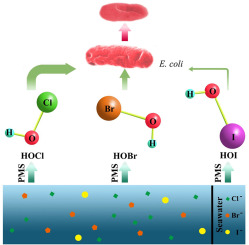当前位置:
X-MOL 学术
›
Chemosphere
›
论文详情
Our official English website, www.x-mol.net, welcomes your feedback! (Note: you will need to create a separate account there.)
Efficient inactivation of bacteria in ballast water by adding potassium peroxymonosulfate alone: Role of halide ions.
Chemosphere ( IF 8.8 ) Pub Date : 2020-04-05 , DOI: 10.1016/j.chemosphere.2020.126656 Xiangqian Xu 1 , Zhilin Ran 2 , Gang Wen 1 , Zhiting Liang 1 , Qiqi Wan 1 , Zhuhao Chen 1 , Yuzhao Lin 1 , Kai Li 1 , Jingyi Wang 1 , Tinglin Huang 1
Chemosphere ( IF 8.8 ) Pub Date : 2020-04-05 , DOI: 10.1016/j.chemosphere.2020.126656 Xiangqian Xu 1 , Zhilin Ran 2 , Gang Wen 1 , Zhiting Liang 1 , Qiqi Wan 1 , Zhuhao Chen 1 , Yuzhao Lin 1 , Kai Li 1 , Jingyi Wang 1 , Tinglin Huang 1
Affiliation

|
In recent years, ballast water disinfection has been paid much more attention due to the untreated discharged ballast water posing threaten of biological invasion and health related consequences. In this study, an effective and simple approach for ballast water disinfection by just adding potassium peroxymonosulfate (PMS) was assessed, and the role of halide ions in seawater on the enhancement of inactivation was revealed. The reactive species responsible for inactivation, the leakage of intracellular materials, and changes of cellular morphology after inactivation were evaluated to explore the inactivation mechanism. The results showed that Escherichia coli and Bacillus subtilis in ballast water could be totally inactivated within 10 min by adding 0.2 mM PMS alone. The inactivation of bacteria in ballast water fitted to the delayed Chick-Watson model. Chloride and bromide ion in seawater were found to play a crucial role in inactivating bacteria, while the effect of iodide ion could be negligible due to its relative lower concentration in seawater. Chlorine and bromine, produced by the reaction of PMS with chloride and bromide ion, were proved to be the main reactive components that were responsible for the inactivation of bacteria. The extracellular ATP and total nitrogen concentration increased after inactivation which indicated that cell membrane was destroyed by reactive oxidants produced by the reaction between PMS and halide ions. The change of cell morphology confirmed that bacteria were seriously damaged after inactivation. The results suggest that PMS is an attractive alternative disinfectant for ballast water disinfection and this application deserved further research.
中文翻译:

单独添加过氧一硫酸钾可以有效地使压载水中的细菌失活:卤离子的作用。
近年来,由于未经处理的压载水未经处理就构成了生物入侵和健康相关后果的威胁,压载水消毒受到了更多关注。在这项研究中,评估了仅添加过氧一硫酸钾(PMS)进行压载水消毒的有效简单方法,并揭示了海水中卤离子对增强灭活作用的作用。评价了引起失活,细胞内物质泄漏和失活后细胞形态变化的反应性物种,以探索失活机理。结果表明,仅添加0.2 mM PMS,压载水中的大肠杆菌和枯草芽孢杆菌可在10分钟内完全灭活。压载水中细菌的失活符合延迟的Chick-Watson模型。已发现海水中的氯离子和溴离子在灭活细菌中起关键作用,而碘离子由于在海水中的浓度相对较低,因此其影响可忽略不计。PMS与氯离子和溴离子反应生成的氯和溴被证明是导致细菌失活的主要反应性成分。灭活后细胞外ATP和总氮浓度增加,这表明细胞膜被PMS和卤离子之间的反应所产生的反应性氧化剂破坏。细胞形态的变化证实了灭活后细菌被严重破坏。
更新日期:2020-04-06
中文翻译:

单独添加过氧一硫酸钾可以有效地使压载水中的细菌失活:卤离子的作用。
近年来,由于未经处理的压载水未经处理就构成了生物入侵和健康相关后果的威胁,压载水消毒受到了更多关注。在这项研究中,评估了仅添加过氧一硫酸钾(PMS)进行压载水消毒的有效简单方法,并揭示了海水中卤离子对增强灭活作用的作用。评价了引起失活,细胞内物质泄漏和失活后细胞形态变化的反应性物种,以探索失活机理。结果表明,仅添加0.2 mM PMS,压载水中的大肠杆菌和枯草芽孢杆菌可在10分钟内完全灭活。压载水中细菌的失活符合延迟的Chick-Watson模型。已发现海水中的氯离子和溴离子在灭活细菌中起关键作用,而碘离子由于在海水中的浓度相对较低,因此其影响可忽略不计。PMS与氯离子和溴离子反应生成的氯和溴被证明是导致细菌失活的主要反应性成分。灭活后细胞外ATP和总氮浓度增加,这表明细胞膜被PMS和卤离子之间的反应所产生的反应性氧化剂破坏。细胞形态的变化证实了灭活后细菌被严重破坏。



























 京公网安备 11010802027423号
京公网安备 11010802027423号